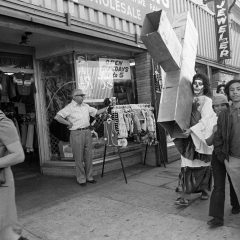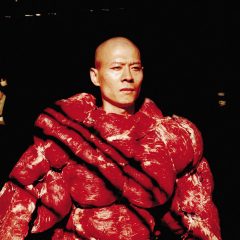It’s the Political Economy, Stupid is an exhibition of work by ten artists or collectives, at the Austrian Cultural Forum through April 22, 2012. Curated by Oliver Ressler and Gregory Sholette, this is a smart exhibition that I suspect will be preaching to the converted, but in style. By means of a slide show, sculptural installation, wall drawing, and numerous, single-channel videos, the international group of artists address the politics of our current economic crisis. This is the gallery version of Occupy Wall Street.
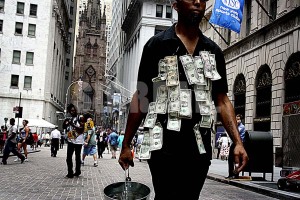
Dred Scott literalized the metaphor of money to burn by asking volunteers on Wall Street to help him immolate dollar bills (a performance reminiscent of William Pope L.’s ATM Piece of 1997). Isa Rosenberger records a Weimar-era dance piece whose message remains relevant. The slide show by Julia Christensen is a remarkably up-beat documentary of abandoned big box stores across America that have been converted into health clinics, cultural programs and day-care facilities.
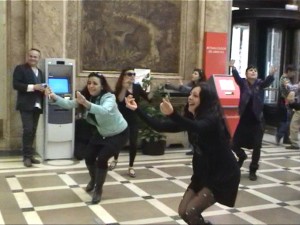
My favorite work was by the Spanish collective, flo6x8, who organized flash mobs to perform flamenco dances in bank lobbies, often to plaintive songs about the misdeeds of the financial sector. Their video inter-cut straight documentary with the same scenes, supposedly caught by ubiquitous security cameras. Their work has a manic humor, as bank employees and customers are startled, amused or angered when their everyday business is disrupted by dancers.

Most of the other videos told more or less the same story of the corrupt financial industry and the governments that supported it, but in different settings and with some technical variety. They are best if you see only several minutes of each; if you try to see them all in their entirety, the sameness is a limitation. Other artists in the exhibition are: Yevgeniy Fiks, Olga Kopenkina and Alexandra Lerman; Jan Peter Hammer and Melanie Gilligan; the Institute for Wishful Thinking; Zany Begg and Oliver Ressler; Alicia Herrero; and Linda Bilda. A program of events, including performances and readings by Reverend Billy, Dread Scott, Larry Bogad, Pablo Helguera, Martha Rosler, and The Yes Men, will take place during the run of the exhibition.

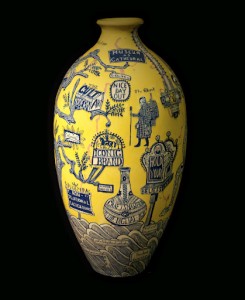
I support anything that brings new perspectives to museum collections, and nothing has been more successful at re-contextualizing collections than exhibitions organized by artists at numerous museums (which I’ve written about previously, on Jan. 31, 2011 and Jan. 3, 2009). No one has more invested in museum collections than artists, for whom they function as primary textbooks. And artists are free from the conventions of art history and the ethics of curatorial practice. The British Museum asked Grayson Perry to address its collections, and I’ve never seen an artist do a better job of it.
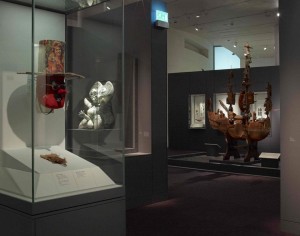
Perry turns out to be a wonderful teacher in The Tomb of the Unknown Craftsman, which has been extended to Feb. 26, 2012. In displaying a selection of his large, figured pots alongside his choices from the museum storerooms, Perry sidestepped questions of technique and style (which he has obviously studied seriously) to concentrate on the objects’ uses. In doing so, he gave currency to a motley selection of objects, produced by anonymous craftsmen (hence, the exhibition’s title) over several thousand years of civilization.
He ignored obvious masterpieces in favor of objects that were mundane and occasionally fragmentary. Some were used as reliquaries, others were associated with shamanistic rituals and a number were pilgrimage souvenirs. He related his own transvestism to objects used in ceremonies of sexual role-playing, and ended the exhibition with his own, extravagant version of objects meant to accompany the dead on their journey.
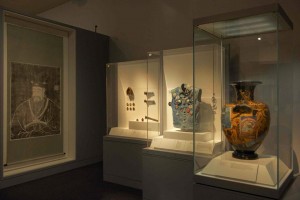
The artist says it best: The Tomb of an Unknown Craftsman is of a treasure hoard from a distinct civilization. The difference is that it is a civilization of one. The territory it springs from is my imagination. … The relationship between my personal themes and obsessions and the vastness of world culture …




